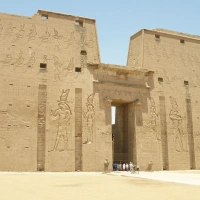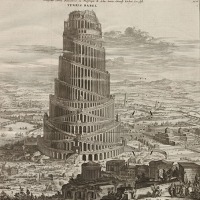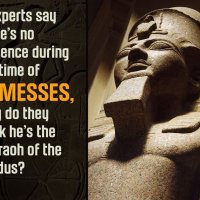
Tower of Babel
“will reach into heaven” (Gen 11:4)
An astounding event at the Tower of Babel over 4,000 years ago made language translation necessary today.
The History Book of the Universe records a remarkable series of events. Noah’s family disembarked from the Ark after the Great Flood (Genesis 6:1-9:19) around 2500 BC. God clearly instructed Noah and his sons to “Be fruitful and multiply, and fill the earth.” (Genesis 9:1,7)
Did Noah’s descendants listen to God? No, the clan settled on the plain of Shinar. They made no attempt to spread out and fill the earth. On the contrary, they stuck together to build a Tower, defying God’s order to re-populate the earth. Yahweh therefore confused the language of the Tower builders to force them to scatter across the face of the earth (Genesis 11:1-9).
Where Was the Tower of Babel?
Scripture says the people built the Tower in Babel on the plain of Shinar. Where were Shinar and Babel?
Shinar was somewhere in Mesopotamia, but no one knows for sure the exact location of the Tower of Babel. Shinar means the “land of two rivers” in Hebrew (shene nahar). This is similar in meaning to the Greek word Mesopotamia (“between the rivers”) for the area of the Tigris–Euphrates river system.
The traditional view is that Shinar is the Chaldean region of southern Babylonia in present-day Iraq. It identifies Babel with Babylon which lies about 50 miles south of today’s Baghdad. (See the Babel-Babylon and Shinar articles in the International Standard Bible Encyclopedia for this view.)
A competing view, which has a lot to recommend it, is that Shinar and Babel were in northeastern Syria in northern Mesopotamia, instead of in central Mesopotamia at Babylon. See Habermehl’s Where in the World Is the Tower of Babel? for a strong argument in favor of this position. William F. Albright, the dean of Biblical Archaeology, was one who espoused this view. (See the article “Shinar–Sangar and Its Monarch Amraphel” by W. F. Albright in The American Journal of Semitic Languages and Literatures, volume 40, no. 2:125–133, 1924.)
Shinar was a well-known area in Bible times and is mentioned later in Scripture. After settling in Canaan, one of the kings Abraham fought and defeated was Amraphel king of Shinar (Genesis 14:1,9). Achan stole a “beautiful mantle from Shinar” at the battle of Ai (Joshua 7:21). Shinar is also mentioned in Isaiah 11:11 and Daniel 1:2 (around 600 BC) and Zechariah 5:11. From these passages, the impression is that Shinar was closer to Canaan than southern Mesopotamia was. Northeast Syria would fit.
As Habermehl points out, the ancient Greeks understood Shinar to be northern Mesopotamia. Many scholars of the 18th and early 19th centuries placed Shinar and Babel in northeastern Syria (northern Mesopotamia).
The city of Sinjar and the nearby Sinjar Mountains (also called Shengar or Shengal Mountains) in northwestern Iraq suggest that Shinar was in northern Mesopotamia, because “Sinjar/Shengar/Shengal” is a form of Shinar. The Sinjar Mountains are west of today’s city of Mosul in the Nineveh Governorate. Mosul lies across the Tigris River from the ruins of Nineveh.
The Sinjar Mountains are a single ridge of mountains almost 50 miles long running east-west with height about 4,450 ft. Although not labeled, the Sinjar Mountains can be seen on the above map. Look west of Mosul at the small horizontal shadow mark for the Sinjar (Shinar) mountain range.
The mountains are mainly inhabited by Yazidis who believe the highest one is where Noah’s Ark landed. This is unlikely because Genesis 11:2 indicates Noah’s clan traveled some ways eastward or from the east before finding the Shinar plain. It’s interesting that on the Yazidi calendar, April 2013 marks the beginning of their year 6,763, so the year of Creation according to their reckoning would be 4,751 BC in the Gregorian calendar (there’s no year 0 between 1 BC and AD 1). This date isn’t too far off from what the Genesis chrono-genealogies give.
The Biblical plain of Shinar would be between the Chabur River to the west and the Tigris River to the east on the above map. It would lie south of the Turkish mountains and north of the Sinjar Mountains. This region meets the Biblical description of “a plain in the land of Shinar,” for it is perfectly flat as far as the eye can see (Genesis 11:2).
A third possibility is that the Tower of Babel was in southern Mesopotamia near the Persian Gulf. According to this theory, Shinar is ancient Sumer, and the sea of Shinar mentioned in the apocryphal Book of Jubilees is the Persian Gulf. The Book of Jubilees says the Tower builders cemented the bricks together with “asphalt which comes out of the sea, and out of the fountains of water in the land of Shinar.”
(See The Book of Jubilees, chapter 10, vs 20-21, R.H. Charles translation)
This leads some to think Babel was near the Persian Gulf, although bitumen (asphalt) is available all over Iraq, Syria, and Turkey.
Those favoring this theory believe the Tower was built in Eridu, an ancient city claiming to be the oldest city in the world. Eridu is about 7 miles southwest of Ur. It was once on the Persian Gulf near the mouth of the Euphrates River. The ruins of a massive, ancient ziggurat mortared with bitumen are in Eridu. Some believe these are the ruins of the Tower of Babel.
So…Where Was the Tower of Babel?
Was it in northeastern Syria in northern Mesopotamia, or was it at Babylon in central Mesopotamia, or was it in southern Mesopotamia at Eridu near the Persian Gulf?
A definitive answer to this question cannot yet be given. The question requires more historical and archaeological research. Based on the present state of knowledge, I think the northern Mesopotamia location in northeastern Syria is the most likely region for the plain of Shinar.
Even though nobody knows the exact location of the Tower of Babel today, the broad consensus of opinion is that it was somewhere in Mesopotamia.
Lack of knowledge of the precise location of the Tower of Babel does not impugn the historical value of the Genesis record of the event. The confusion of tongues at the Tower of Babel was a pivotal event of world history. Its consequences have hurtled down through the centuries to our own day. Have you ever struggled to learn another language, or strained to understand someone with a heavy foreign accent? You can credit your rebellious ancestors at the Tower of Babel for contributing to your troubles.
Soli Deo Gloria.
This is the second post in the Tower of Babel series.
(The Translation Page which prompted this series offers automatic translations of the Bible-Science Guy Blog into over 60 languages!)
Read the prequel:
1. Tower of Babel & Language Translation
Subsequent posts will suggest answers to intriguing questions about the Tower of Babel:
What did it look like?
When did the event occur?
What was the common language at Babel?
How many languages did Yahweh create at Babel?
How is Babel a major problem for evolutionists?
Read the sequel:
3. Tower of Babel – What Did It Look Like?
Subscribe – Don’t miss future blog posts!
Click the sidebar’s “SUBSCRIBE” button to follow the
Bible-Science Guy Blog. You’ll automatically receive
new posts free by email. Click SUBSCRIBE NOW!
©William T. Pelletier, Ph.D.
“contending earnestly for the faith”
“destroying speculations against the knowledge of God”
(Jude 1:3; 2 Cor 10:4)
Wednesday March 13, 2013 A.D.
Now the whole earth used the same language and the same words. And it came about as they journeyed east, that they found a plain in the land of Shinar and settled there. And they said to one another, “Come, let us make bricks and burn them thoroughly.” And they used brick for stone, and they used tar for mortar. And they said, “Come, let us build for ourselves a city, and a tower whose top will reach into heaven, and let us make for ourselves a name; lest we be scattered abroad over the face of the whole earth.” And the LORD came down to see the city and the tower which the sons of men had built. And the LORD said, “Behold, they are one people, and they all have the same language. And this is what they began to do, and now nothing which they purpose to do will be impossible for them. “Come, let Us go down and there confuse their language, that they may not understand one another’s speech.” So the LORD scattered them abroad from there over the face of the whole earth; and they stopped building the city. Therefore its name was called Babel, because there the LORD confused the language of the whole earth; and from there the LORD scattered them abroad over the face of the whole earth. (Genesis 11:1-9)





























What a fantastic site and educative posts, I will bookmark your site. Best Regards!
LikeLike
By: Jere Slaton on May 16, 2013
at 6:29 am
I knew it! For me, The Tower of Babel is not in Mesopotamia or some where in the Israel. It is built in Philippines, why ? Dont you ever see it, in every Region here in Philippines they have their own language. Dont you ever think that?
LikeLike
By: Red Franco on June 18, 2015
at 9:27 am
Look to the Hebrew letter ayin (ע) in the word Shinar (שִׁנְעָר). In the paleo-Hebrew writing (pre-Babylonian captivity), the ayin existed as two letters. The glyph of the eye (ayin) had no sound, while the ghah/ghayin glyph of the twisted rope had a “gh” sound. During the Babylonian captivity, the two letters evolved/merged into the modern Hebrew letter of ayin. It is very well possible that the word Shinar in paleo-Hebrew was actually written with the ghah/ghayin glyph, instead of the standard ayin glyph which would thus translate the name as SH-N-GH-R instead of SH-N-R. There just so happens to be a region in northwestern Iraq called Sinjar.
LikeLike
By: Adam on February 19, 2018
at 11:14 am